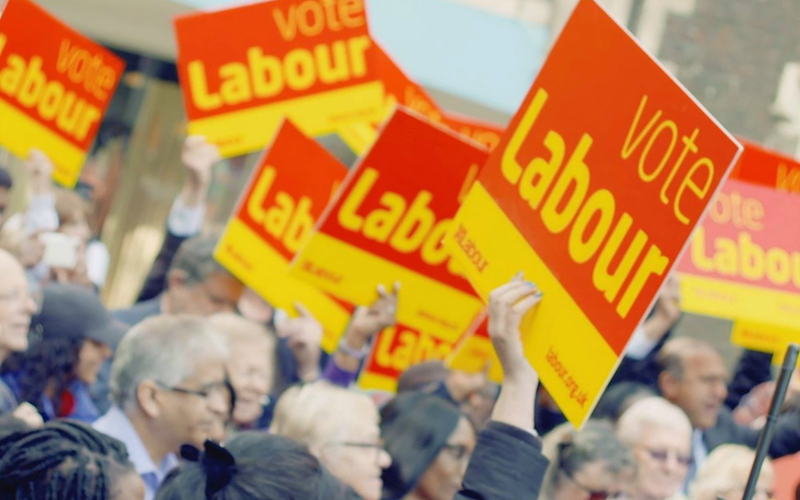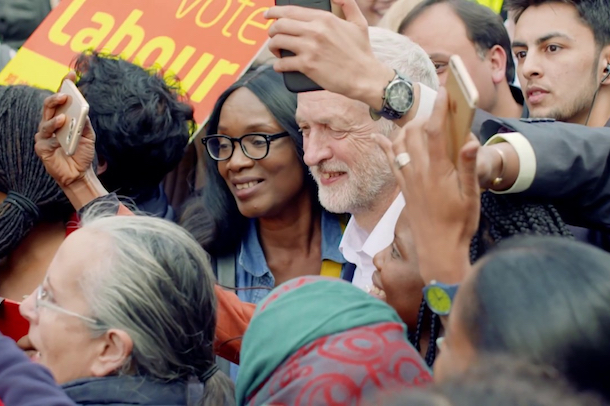
Labour Will Win Because of Better Digital Marketing
If Theresa May called this election because she thought the Tories could easily win, then she’s wrong. Yes, the polls are on her side. Even with Labour gaining ground, the Tories are still comfortably ahead. However, if the rise of Brexit, Trump, and Marine Le Pen have taught us anything, it’s that poll data is — to put it mildly — flawed.
I work for a digital marketing company. Every day, I use data-driven insight to try and discover what works and what doesn’t work about a particular digital marketing campaign. Had people focused more on this sort of insight, then the Brexit result would have been obvious. Vote Leave had a stronger social media following, a stronger message (from a marketing perspective), a better website, and there’s data to back all of this up. Instead, the focus was on polls. Consequently, Brexit came as a complete shock. So too did the rise of Trump. So too did the rise of Marine Le Pen.
So here we are again. Another election in which poll data tells us that one party (the Tories in this case) will clearly obliterate the other. However, when you ignore the polls and instead analyze each party’s digital marketing campaign, then a Labour victory becomes the obvious result.
What do Trump and Corbyn have in common?
It seems like such a farcical question. The first answer which comes to mind is “nothing.” Trump supporters would be horrified at the idea that someone could compare their pro-business, anti-politics, America-first president to a vegetarian socialist. Corbyn supporters would be equally horrified at the idea that someone could compare their pro-NHS, anti-austerity, pacifist MP to a wall-building fascist.
Yet the comparison is valid. Both men have a loyal following who blame a mainstream media conspiracy for their bad coverage. Both men espouse anti-establishment rhetoric (albeit with very different messages). And both men absolutely dominate their rivals when it comes to social media use.
Five years ago, most people would have considered the number of social media followers a politician has, and the level of engagement their social media posts get, as irrelevant. Today, things are different. Trump essentially won the US election by Tweeting. It’s such a radical notion that it’s bizarre to say it out loud, and yet it’s true. By marshalling his enormous following around a simple idea (“Make America Great Again”) with hundreds of 140 character sound bites, Trump was able to appear more transparent, honest, and accessible than his rivals. Whether or not he actually is any of those things is beside the point.
Corbyn is no Trump when it comes to Twitter. His posts still have that Westminster shine about them, whereas Trump always shoots from the hip. What’s more, he has nowhere near as many followers as Trump, either. True, the US has a population six times as large as the UK’s, but Trump has 20 times as many followers as Corbyn. This is because Trump’s appeal extends far beyond politics. Donald Trump is a brand: a real estate magnate, a producer of terrible wine, and a reality TV star who once received a Stone Cold Stunner in a WWE ring.
While the leader of the Labour Party won’t likely be grappling with Steve Austin anytime soon, Corbyn still has a much stronger social media game than any other British politician. With over 860,000 Twitter followers, over 860,000 Facebook followers, as well as a sizable following on other channels, Corbyn’s total social media following completely dwarfs all other British party leaders. He’s also the first major British politician with a Snapchat account.

As a side note, pretty much every major British political party also has its own social media account as well. Once again, Labour dominates here with a stronger Twitter and Facebook following than its rivals’. However, almost all of these accounts are also eclipsed in popularity by the accounts of their respective leaders. Perhaps this is because people are more interested in the leaders than they are in the party itself, a worrying trend in a country which operates under an increasingly unrepresentative political party system, but a trend which political leaders are exploiting nonetheless.
Vote for better websites
There are some truly terrible websites out there for political parties. The SNP’s website still has an out-of-date page about voting on 23rd June 2016. The Conservatives’ website is better. Though with four different calls to action above-the-fold (before you scroll) on the homepage, it’s quite an odd-looking thing.
Still, none of this is as bad as Plaid Cymru’s website. First of all, there’s the domain: www2.partyof.wales for the English version and www.plaid.cymru for the Welsh version. Domain names are important, and getting them wrong can mean that you don’t appear prominently in the Google search results. However, the biggest impact of a weird domain, such as www2.partyof.wales is perception. It doesn’t look like the official domain of an actual political party, but it is.
The website is also laughably unpopular. A quick and easy way to measure the popularity of a website is by checking its Moz DA. This is an internet score which ranks the “size” of a website (according to average monthly visitors as well as the quantity and the quality of links pointing at the site) on a scale of 1 – 100. Every British political party in the UK with MPs sitting in Parliament has a website with a Moz DA of between 40 and 72.
Every party, that is, except Plaid Cymru. Their website has a Moz DA of 1, which is so bad that it’s almost impressive.
The generation of lead generation
The three biggest websites belong to the Conservatives, the Liberal Democrats, and Labour who have Moz DAs of 72, 71, and 70 respectively. However, size isn’t everything. After all, the lifeblood of any campaign depends on two things: money and votes.
Votes are hard things to guarantee. However, if you can get someone to sign up to your newsletter, then that’s a good start. Money’s an easier thing to guarantee, and so you could ask for donations first and foremost. Although, nearly 60% of business owners claim that gathering people’s email addresses and selling to those same people later down the line can be much more effective than giving someone the hard sell straight away.
As a result, lead generation should be the name of the game here. If you can get people to sign up to your mailing list, you can then pitch them your product (in this case, a manifesto) and hopefully they’ll vote for you on 4th June. What’s more, once you’ve got their email, you can then ask these people to donate. eCommerce websites do this sort of thing well all of the time.
Take Amazon, for example. Its homepage contains a well-displayed call to action for Prime Video’s 30-Day free trial. In return for this offer, Amazon asks for your email address and bank accountant details. This then makes it much easier for it to sell you not-free stuff in the following weeks, months, or even years.
A user experience review
We’ve already discussed how the Conservatives’ four different calls to action (“Keep up to date,” “Join today,” “Donate today,” “Get involved”) present a somewhat confused message. Three of the boxes are to the right of an image of Theresa May (not an image of the party or its supporters, just Theresa May) and one is inexplicably above all of this. It’s a thin form in a place where it’s easy to miss.
This thin form is where you can sign up to the mailing list; this is the Tories’ attempt at lead generation. The font for this form is a lot smaller than the font for the other calls to action. It shouldn’t be. The other calls to action are for much bigger commitments (donating, volunteering, and becoming a member). These are things which require time and money. What can I do easily and for free? That’s what the website should be pushing first.
The Liberal Democrats are hardly Amazon, but they do a much better job at lead generation than the Conservatives. Their homepage has just one message above the fold with one call to action: “I’m voting to change Britain’s future on Thursday 8th June.” The mailing list form is right there and only contains four sections.
Labour’s homepage goes one step further. Its call to action doesn’t mention the 8th June. Instead, it counts down by the number of days left. This sort of technique is used by eCommerce websites all the time. You are making people aware of a scarcity of something (in this case a scarcity of time) in order to get them to do something (in this case, to sign up to the Labour mailing list). Labour’s form also shaves precious milliseconds off the Liberal Democrats’ form by asking for just three things: email address, first name, and postcode.
The Tories fare better than Labour and the Lib Dems when it comes to saving time, as their mailing list doesn’t even ask for your first name. However, the user experience once you’ve signed up to the list leaves a lot to be desired. Rather than being taken to a “Thank You” page and being asked for donations, you’re simply presented with the text “Thank you for signing up to our email updates.” Asking someone who has already given you their email address for money is a perfectly sensible eCommerce technique, but it’s one which the Tories ignore here.
“Keep up to date with the campaign” and “Thank you for signing up to our email updates” won’t fill users with excitement. By contrast, Labour and the Lib Dems make their email sign up feel like something monumental. Both websites take you to a “Thank You” page where you’re showered with praise for your support of the cause, not just for “signing up to our email updates.” Both websites then use this golden opportunity to ask for donations.
Lies, damned lies, and web statistics
However, there are downsides to Labour’s strategy. While its website has more visitors than any other British political party at about 300,000 per month on average with over 381,000 visitors in March 2017, it also has a “bounce rate” of over 63%. A “bounce rate” is the percentage of visitors who click through to a page on a website and then leave without clicking anywhere else, and 63% is quite high. The Liberal Democrats do better with a bounce rate of under 50%, but they only average around 200,000 visitors a month with just over 177,000 visitors in March. Finally, you have the Conservatives’ website which has an excellent bounce rate of 36% but an average of about 160,000 visitors per month with over 163,000 visitors in March.
Labour’s and the Liberal Democrats’ higher bounce rates are likely to do with the fact that users are immediately presented with a form for lead generation. While this likely means that they both have bigger mailing lists, this approach could scare some casual web users away. With the Conservatives’ website, while their homepage is a bit messy, it’s not as intimidating and so people are likely to hang around longer and click through to few pages.
All in all, though, Labour’s strategy is working better than the Tories’. 63% is high, but 37% of 381,000 people in March clicked through to other parts of the Labour website. That’s 140,000 people. The Tories’ low bounce rate is commendable, but 64% of their 163,000 visitors in March is just over 100,000 people. In terms of sheer numbers, Labour is winning here.
Who will win the election? Just ask Google
While “Labour Party” is only trending slightly better on Google (as opposed to “Conservative Party” and “Tory Party”), Labour clearly beats its rivals for the term “Vote Labour” (as oppose to “Vote Tory,” “Vote Conservative,” “Vote SNP,” or “Vote UKIP”). Part of this could be due to the fact that Labour is known as simply “Labour” while “Vote Tories,” “Vote Tory,” “Vote Conservative,” and “Vote Conservatives” are all synonymous. However, even when you strip the searches down to their most literal (“Vote Labour Party” vs. “Vote Conservative Party”), Labour still comes out on top.
More people searching “Labour Party” than “Conservative Party” isn’t necessarily a positive. These kinds of Google queries are known as informational search terms. In other words, a person Googles “Labour Party” because they’re interested in it. This interest can be a good thing. The Labour Party’s website is the first result for this search term and (as was previously discussed) it’s a good website. Of course, interest can also be a bad thing. In Mexico,“Donald Trump” has been a much more popular search term than Mexico’s own president since the start of 2015.
However, imperative sentences term like “Buy iPhone,” “Sell Xbox,” and “Vote Labour” are transactional search terms. As such, the people who Google “Vote Labour” are people who are looking to vote Labour. The fact that Labour is crushing its rivals when it comes to this term is unambiguously a good thing.
But personalities matter too, and this is where Labour’s lead shrinks. While “Vote May” is likely bolstered by the fact that people are inquiring about votes happening in May (such as the local elections),“Vote Theresa May” still smashes “Vote Jeremy Corbyn.”
Labour can take solace in the fact that this is a race between parties, not leaders, and that people are aware of this. So while the aforementioned social media analysis shows that people are more interested in leaders, Google Trends analysis shows that most people still think in terms of “Vote Party X” rather than “Vote Leader X.”
At the very least, it’s fair to say that Theresa May underestimated Labour’s chances when she called this election. At the very least, it’s fair to say that the poll data is only one side of the story. At the very least, it’s fair to say that Labour could win this election. However, the gambling man in me says that Labour will win this election and that the reason is better digital marketing.

